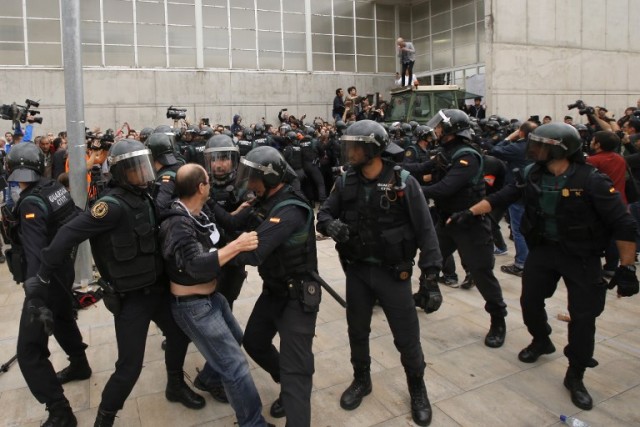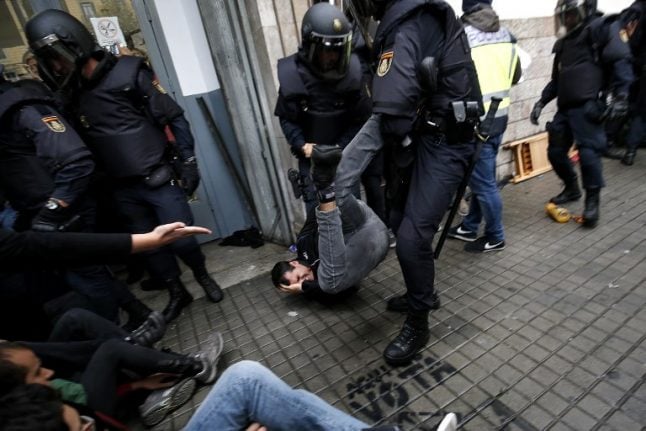Taking the stand as witnesses at Spain's Supreme Court in Madrid, those responsible for the police operation that prevented some from voting in the October 1st, 2017 referendum gave their version of events in public for the first time.
Footage beamed around the world showed police dragging voters from polling stations by their hair, throwing people down stairs and striking them with batons, sparking shock and complaints from human rights groups.
ANALYSIS: Why the Catalan Republic is a big fat lie
A court order had instructed Catalonia's regional police, the Mossos d'Esquadra, to work with Spain's national police to stop the plebiscite, which was ruled illegal by Spain's Constitutional Court.
But security officials charged that the Mossos did not comply as their leaders sided with Catalonia's separatist government, leaving it to national police to seize ballot papers and boxes, leading to clashes in roughly 30 polling stations.
'Surreal' situation

Clashes outside a polling station in Sant Julia de Ramis,, on October 1st 2017. Photo: AFP
Diego Perez de los Cobos, a colonel at Spain's Civil Guard police force in charge of police operations that day, said the leadership of the Mossos went against the court order and set about facilitating the vote “rather than preventing it.”
He said that on “10 or 11” occasions, the Mossos “tried to physically obstruct the actions of our own forces”.
During security meetings ahead of the vote, Mossos head Josep Lluis Trapero sided “completely” with Catalonia's regional government which called the referendum, Spain's former secretary of state for security, Jose Antonio Nieto, told the court.
“The situation was surreal. We were sitting around a table to stop the referendum with those who organised it,” said Nieto, who was then the second-highest ranking official at Spain's interior ministry.
“Fairy trap”
Trapero faces a separate trial for rebellion.
Nine of the 12 Catalan separatist leaders on trial in the Supreme Court have also been charged with rebellion for their role in staging the referendum and a short-lived independence declaration that followed.
Public prosecutors are calling for them to be sentenced to up to 25 years in jail.
Catalan separatists argue their majority in the regional Catalan parliament gave them a democratic mandate to pursue independence.
But prosecutors accuse the separatist leaders of violating the law and using crowds to block police on referendum day.
National police who went to polling stations were met in some cases with “human walls” of people who were sometimes violent, Enric Millo, who was Madrid's representative in Catalonia during the 2017 crisis, told the court on Tuesday.
Police responded “proportionally”, he said.
Probe into police violence
While the world saw images of police striking would-be voters with their batons, they did not see images of injured officers, Millo added.
According to the Spanish government, close to 100 police were hurt, none hospitalised.
Millo however said some officers suffered broken fingers or fractured legs.
Some were hit with metal barriers or cobblestones, he added.
Others fell in the “Fairy trap”, said Millo, in reference to a brand of dishwashing liquid which he said was spilled in the entrance of polling stations, causing officers to slip, fall before people hit their heads.
Nieto said police ended up pulling back as the security of people and agents was “at serious risk.”
Catalonia's separatist government says seven people were seriously injured that day, including one man who lost an eye due to a rubber bullet fired by police.
Under questioning from the defence, Nieto acknowledged that “dozens” of officers were under investigation for police violence during the referendum.
Establishing whether or not separatists used violence is key to proving the charge of rebellion, which under Spanish law is defined as “rising up violently and publicly”.
The separatist leaders have always denied exercising any form of violence, insisting on the pacific nature of the independence movement.
By AFP's Diego Urdaneta
READ ALSO: Catalan separarists' trial: What you need to know



 Please whitelist us to continue reading.
Please whitelist us to continue reading.
Member comments